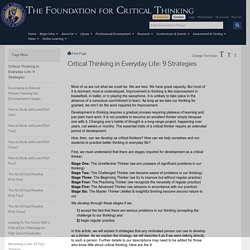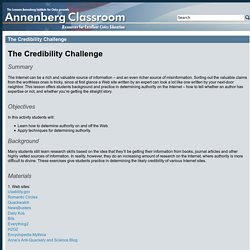

Welcome to our virtual Games Room! Mensa for Kids. Primary Sources. Free logical fallacy poster. Fallacies. Dr.

Michael C. Labossiere, the author of a Macintosh tutorial named Fallacy Tutorial Pro 3.0, has kindly agreed to allow the text of his work to appear on the Nizkor site, as a Nizkor Feature. It remains © Copyright 1995 Michael C. Labossiere, with distribution restrictions -- please see our copyright notice. If you have questions or comments about this work, please direct them both to the Nizkor webmasters (webmaster@nizkor.org) and to Dr. Other sites that list and explain fallacies include: Constructing a Logical Argument Description of Fallacies In order to understand what a fallacy is, one must understand what an argument is.
There are two main types of arguments: deductive and inductive. A fallacy is, very generally, an error in reasoning. Critical Thinking. Chapter 1.

Critical Thinking in Everyday Life: 9 Strategies. Most of us are not what we could be.

We are less. We have great capacity. But most of it is dormant; most is undeveloped. Improvement in thinking is like improvement in basketball, in ballet, or in playing the saxophone. It is unlikely to take place in the absence of a conscious commitment to learn. Development in thinking requires a gradual process requiring plateaus of learning and just plain hard work. How, then, can we develop as critical thinkers?
First, we must understand that there are stages required for development as a critical thinker: We develop through these stages if we: In this article, we will explain 9 strategies that any motivated person can use to develop as a thinker. There is nothing magical about our ideas. First Strategy: Use “Wasted” Time. The key is that the time is “gone” even though, if we had thought about it and considered our options, we would never have deliberately spent our time in the way we did. When did I do my worst thinking today? PHIL102: Logic and Critical Thinking. Please note: this legacy course does not offer a certificate and may contain broken links and outdated information.

Although archived, it is open for learning without registration or enrollment. Please consider contributing updates to this course on GitHub (you can also adopt, adapt, and distribute this course under the terms of the Creative Commons Attribution 3.0 license). To find fully-supported, current courses, visit our Learn site. This course provides an introduction to critical thinking, informal logic, and a small amount of formal logic. Its purpose is to provide you with the basic tools of analytical reasoning, which will give you a distinctive edge in a wide variety of careers and courses of study. Learning Outcomes Upon successful completion of this course, students will be able to: CHARACTER COUNTS! Ethics in America. 1.

Do Unto Others Must we house the homeless or report a child abuser? A panel including Surgeon General C. Everett Koop, Faye Wattleton of Planned Parenthood, and Willard Gaylin of the Hastings Center discusses the question of community responsibility. 2. To Defend a Killer What rights do the guilty have? Teaching Ethics. The Credibility Challenge.
Summary The Internet can be a rich and valuable source of information – and an even richer source of misinformation.

Sorting out the valuable claims from the worthless ones is tricky, since at first glance a Web site written by an expert can look a lot like one written by your next-door neighbor. This lesson offers students background and practice in determining authority on the Internet – how to tell whether an author has expertise or not, and whether you’re getting the straight story.
Objectives In this activity students will: Learn how to determine authority on and off the Web. Background Many students still learn research skills based on the idea that they’ll be getting their information from books, journal articles and other highly vetted sources of information. Materials. Intermediate Writing: Research Writing in a Persuasive Mode. Image courtesy of Mathias Lux Course Description Course Objectives The purpose of this course is to help you implement the critical reading and thinking skills and strategies necessary to the practice of persuasive research writing.

Because the focus of this class is the process of learning how to argue effectively on paper, you will have the opportunity to develop an awareness of audience by writing multiple drafts, which will include well-documented, credible research sources. Critical Thinking Curriculum - Critical Voter. Introduction to Critical Thinking. Upload Wi-Phi Wireless Philosophy Loading...

Working... ► Play all Introduction to Critical Thinking Wireless Philosophy32 videos91,800 viewsLast updated on Sep 20, 2016 Play all Sign in to YouTube Sign in History. Think101x: The Science of Everyday Thinking (edX) Skool of Creativity: Essentials. Brain Pickings. Edward de Bono. AUSTIN KLEON is a writer who draws. Mensa for Kids.